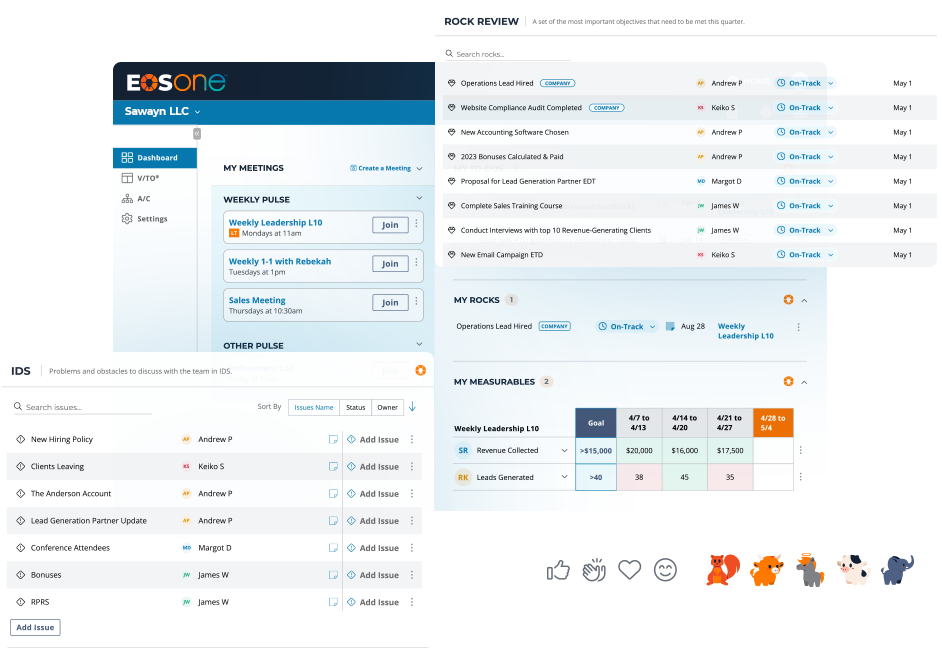Who is responsible for what?
This is one of the most important questions a growing business can answer. Without clear roles and accountability, a business can’t gain Traction or get healthy.
That’s where the Entrepreneurial Operating System (EOS)® and its game-changing tool, the Accountability Chart®, come into play. This isn’t your ordinary org chart. It’s the blueprint for clear roles and responsibilities.
Understanding the Accountability Chart
At the heart of every streamlined business operation lies a crystal-clear understanding of who is accountable for what—this is the essence of the Accountability Chart within the EOS® framework.
Unlike your typical organizational chart, which merely outlines job titles and hierarchical relationships, the Accountability Chart goes several steps deeper. The EOS® Accountability Chart:
- Ensures every person is in the right seat, they get it, want it, and have the capacity to do it
- Aligns roles and abilities with the company’s overall vision
- Replaces vague, ego-driven titles with precise, defined accountability seats
By ensuring that responsibilities are clear, the Accountability Chart becomes more than just a tool; it’s a foundational element for driving accountability and fostering a healthy, productive business environment that gets consistently great results.
Refining Your Accountability Chart
Now let’s consider a step-by-step process for improving your EOS® Accountability Chart:
1. Start with the Major Functions of Your Organization
It’s tempting to start with the people you already have on your team. But resist the urge to write down their job titles right away. Instead, take a big step back and look at the three major, basic functions of every organization:
- Marketing/Sales function where team members go out into the marketplace, create demand, and turn that demand into orders.
- Operations function where team members build a product or deliver a service
- Finance function where team members track money flowing in and out of the organization, deal with financial controls, acquire and manage assets, etc.
These are the core functions every business needs to run day-to-day and achieve your vision. Every single function or seat needs to be strong or else your business cannot succeed.
*Your organization will also have an Integrator™ major function and a Visionary™ major function.
2. Customize the Seats
Decide on what major functions or seats you need to take your company to the next level. Three to seven is the rule of thumb.
In your organization, you may choose to split up Marketing/Sales into a Marketing seat and a Sales seat. Operations may need multiple seats. Finance may also include an HR seat. Decide on what the seats are that make your company work.
You’ll end up with the right, simplest, and best structure to execute well for the next 6-12 months.
3. List the 5 Major Roles for Each Seat
With the seats of your leadership team customized to your organization, now consider roles for each. Agree on a simple way to describe what each leader is accountable for. (Consider a 20/80 approach.)
What do you want this seat to deliver to your organization?
Write out five roles for each seat, being careful to avoid any overlap. Remember, when more than one person is accountable, no one is accountable.
At this point, make sure you focus on the work that needs to be done, not existing job titles.
4. Place the Right People in the Right Seats
Up to this point, you’ve only been working with structure, not specific team members. This is important to objectively align the company’s needs with the right structure.
But now that the structure is established, it’s time to assign individuals to each seat.
Here you want to use GWC™(Get it, Want it, Capacity to do it). You’re looking for individuals who:
- Get It: have the aptitude, natural ability, and thorough understanding of the ins and outs of the job
- Want It: sincerely desire the role
- Have Capacity: possess the emotional, intellectual, physical, and time capacity to do the job
Each seat should be filled by someone who meets all three criteria. Don’t settle for two or you risk an ineffective Accountability Chart.
Once you’ve put the right name in each seat, you’ll have a clear and actionable chart
Ambiguity to Clarity
Transitioning from ambiguity to accountability within your organization is crucial for clarity, efficiency, and overall success. An effective Accountability Chart is key to this transformation, ensuring that every team member understands their role and responsibilities. We encourage you to revisit your current Accountability Chart with a fresh perspective, identifying areas for refinement. For a more in-depth review and optimization of your chart, consider engaging with an EOS Implementer. Their expertise can provide invaluable guidance, helping you to further clarify roles and enhance accountability within your team.

